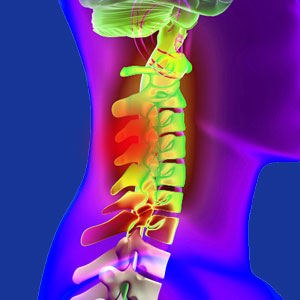
Cervical facet joint pain is not an inherent result of zygapophyseal deterioration. In fact, statistics clearly reveal that only rare cases of facet joint degeneration are symptomatic. However, for patients who suffer from painful facet joints in the neck, this truth is of no comfort or consequence. These patients only want to find relief from their nagging pain. Cervical facet joint syndrome is a common diagnosis, as well as a well known misdiagnosed condition in many patients. It is completely normal to demonstrate facet joint arthritis as we age. However, only rare cases of degeneration will create any significant symptoms. This makes facet syndrome a very common scapegoat condition on which pain can be blamed, much akin to degenerative disc disease, herniated discs and general osteoarthritis in the spine.
This essay presents the reasons why facet joint deterioration might become painful. We will explore the logical expressions of facet syndrome, as well as provide tips for identifying patients who might have been misdiagnosed with facet disease.
Cervical Facet Joint Pain Misconceptions
Arthritis is almost universal in the cervical facet joints. These regions are forced to move continuously throughout life and are notorious for developing early age-related structural changes in response to various stresses. Most people will demonstrate marked deterioration of one or more facet structures by the age of 40, while others will display similar changes much younger. The most common locations for facet joint degeneration occur between C4 and T1, with upper facet joint pain syndromes being very rare.
Arthritis creates a breakdown in the protective mechanisms of the zygapophyseal joints. Protective cartilage is worn away and lubricating synovial fluid dries up. These facts cause the escalation of bone-to-bone interactions between vertebrae. These increased interactions result in the development and accumulation of arthritis debris and bone spurs (osteophytes) in and around the facet joints. All of this is completely normal and expected. Some doctors vilify these changes as being pathological, when in truth, there is no evidence that this is the case. We all demonstrate the deterioration of the facet joints, but only a few people develop painful conditions known as facet syndrome. Therefore, while facet syndrome does exist, and can become quite painful in rare instances, many cases are mistakenly identified as the source of pain, which explains why many patients suffer disappointing therapeutic results from treatment.
Facet Joint Pain Mechanisms in the Neck
Facet degeneration can become problematic when certain scenarios occur. The following are mechanisms that can generate pain in association with facet joint arthritis:
Sometimes, tiny nerves which innervate the facet joint capsule are theorized to be compressed by the growth of arthritic accumulations. In these cases, pain should be mild and extremely localized to highly specific regions of each joint. The idea of severe or wide-ranging symptoms in association with this variety of facet syndrome is structurally illogical.
In most instances, facet syndrome is suspected of causing mechanical pain due to the development of bone spurs that interfere with normal mobilization of the joint. Since the facet joints move constantly, patients who do develop problematic osteophyte spurring might suffer mild to moderate symptoms enacted by movement of the affected joint. In rare cases, pain might be severe and the joint might even suffer reduced range of motion based not on pain, but on actual structural physical impediment to motion.
When widespread neck pain is blamed on facet syndrome, the diagnosis is virtually always wrong. When pain is ever-present, the diagnosis is virtually always incorrect. When the pain exists off the spine, the diagnosis is virtually always wrong, as well. None of these facts prevent misdiagnosis in countless patients each year.
Relief from Cervical Facet Joint Pain
For truly symptomatic versions of facet joint arthritis, there is hope for a true cure, but this might entail invasive care for some patients. Others might achieve relief using nonsurgical methods of treatment.
Symptomatic care comes in a wide range of choices, but will never cure the pain. Instead, these pain-targeting modalities will only reduce the severity of symptoms temporarily, making them substandard to the curative therapies detailed below.
Nonsurgical spinal decompression is used to treat many cases of facet syndrome with adequate results. Outcomes for facet arthritis are not as promising as for disc pain sufferers, but considering the low degree of risk, decompression is still a very viable choice for curative care.
Facet joint surgery can resolve many structural issues that can cause pain. Most of these procedures are minimally invasive and are well tolerated. Results are generally good when the diagnosis is sound and the risks are far lower than most other forms of spinal surgery. When surgical intervention fails, it is almost always a result of misdiagnosis and not due to any blunder during the surgical process.
Neck Pain > Facet Joint Neck Pain > Cervical Facet Joint Pain





